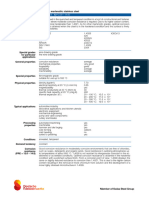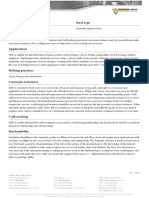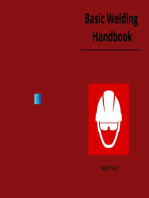En 1 4305 - 1408 Valbruna Nordic English
En 1 4305 - 1408 Valbruna Nordic English
Uploaded by
Dule JovanovicCopyright:
Available Formats
En 1 4305 - 1408 Valbruna Nordic English
En 1 4305 - 1408 Valbruna Nordic English
Uploaded by
Dule JovanovicOriginal Title
Copyright
Available Formats
Share this document
Did you find this document useful?
Is this content inappropriate?
Copyright:
Available Formats
En 1 4305 - 1408 Valbruna Nordic English
En 1 4305 - 1408 Valbruna Nordic English
Uploaded by
Dule JovanovicCopyright:
Available Formats
Free-Machining Austenitic Stainless Steel
EN 1.4305 – AISI T 303
A stainless austenitic steel
EN 1.4305 is a free-machining austenitic stainless
Typical analysis C max Cr Ni S
steel. The excellent machinability is due to its
% 0,10 18,0 9,0 0,25
sulphur content of between 0,15 - 0,30 %. It has
Delivery condition Solution annealed
good resistance to atmospheric corrosion and to
( Replaces SS 2346 –02 )
many organic and inorganic chemicals.
Mechanical properties
Values for solution annealed condition to EN 10088 - 3 It is non-magnetic in the annealed condition but
2
may become slightly magnetic due to the
Tensile strength Rm N/mm introduction of martensite or ferrite at the cold-
500-750
2 working or welding stages.
Proof strength Rp02 N/mm min 210
Elongation A5 % min 35 Design features
Relatively good corrosion resistance
Hardness HB Max 230
Excellent machinability
Cold-worked material:
The maximum HB-values may be raised by 100 HB or Corrosion resistance
2
the Tensile strength value may be raised by 200 N/mm
and the Elongation value lowered to 20 % for EN 1.4305 has relatively good resistance to
bars < 35 mm- atmospheric corrosion with some restrictions
particularly regarding marine and coastal
Characteristic temperatures environments.
Temperature C
° Also the grade has a good resistance to many
(mildly corrosive) organic and inorganic
Solidification temperature 1400
Scaling temperature in air 850-900 chemicals. Somewhat less corrosion resistance
Hot forming 1200-900 compared to EN 1.4307 due to the addition of
Solution annealing 1000-1100 sulphur.
Stress relief annealing 500 Residuals of cutting fluid must be removed by a
(max 5h) degreasing process and the surface need to be
Use in pressure vessels Not approved passivated after machining, to achieve better
corrosion resistance.
Physical properties acc. to EN 10088
Temperature ºC 20 100 200 400 600 800
EN 1.4305 is sensitive to intergranular corrosion
Density due to grain boundary precipitation of chromium
kg/dm3 7,9 carbides, which can occur in the temperature
range 550 - 850ºC.
Modulus of
elasticity E GPa
200 195 185 170 155 135 The resistance to pitting and crevice corrosion is
Mean coeff. of low to moderate. These types of corrosion
thermal expansion typically occur in acidic, neutral or slightly
20ºC –Temp. alkaline solutions and in media with a low chloride
-6 . -1
x10 K - 17,0 17,5 18,5 19,0 19,5 content.
SpecificThermal
.
W/m K 15 15,5 17,5 20,0 22,5 25,5
The grade EN 1.4305 is susceptible to stress
Electrical
Resistivity corrosion cracking. Critical service conditions, i.e.
0,70 0,75 0,80 0,95 1,05 1,15
.
mm /m
2
applications subjected to combinations of tensile
Specific heat stress, temperatures above about 50ºC and
.
J/kg K 440 480 520 560 590 630 solutions containing chlorides, should be avoided.
VALBRUNA NORDIC AB EN 1.4305 1408 ENG 1.
Heat treatment Surface finish
Solution annealing EN 1.4305 is available with ground, peeled and
1000 - 1100ºC. Holding time at solution annealing machined surface. It is not suited to polishing.
temperature approx. 30 min., followed by rapid
cooling in air or water.
Hardening
These grades can not be hardened by heat
treatment. But they can be hardened by cold Stock standard
working. Please refer to our stock standard leaflet.
Fabrication Technical support
Hot and cold forming VALBRUNA NORDIC AB will be helpful in giving
further advice and recommendations concerning
Hot forming should be carried out in the
choice of material, cutting data, heat treatment,
temperature range 1200-900°C. EN 1.4305 is
etc.
difficult to forge since high forging temperature is
required and that implies a risk of over- heating
and hot cracking. It is important that the entire
workpiece has been exposed to a sufficiently high
MATERIAL STANDARDS
temperature. In the case of partial heating, or
cooling that is too slow, hot working should be
followed by solution annealing. Bending, pressing EN 10088-3 Stainless steels - Semi-
and other forming operations can be done in cold finished products, bars,
condition, but austenitic steels without sulphur rods, sections for general
has better cold forming properties. purposes
ASTM A 582 Standard Specification for
Free-Machining Stainless
Machining
Steel Bars
EN 1.4305 is a Free-Machining Stainless Steel
and is designed for further processing by
machining. The steel is alloyed with 0,15 – 0,30 %
sulphur which creates a considerable quantity of
sulphides in the material. The sulphides improve
the machinability, and particulary chip-breaking,
but have the drawback of substantially degrading
weldability, toughness, corrosion resistance and
hot workability.
Welding
EN 1.4305 is designed to optimize machinability.
The high sulphur content makes it susceptible to
hot cracking during welding and as such welding
of this steel is not recommended.
THE DATA CONTAINED HEREIN ARE INTENDED AS REFERENCE ONLY AND MAY BE REVISED AT ANY TIME WITHOUT PRIOR NOTICE.
VALBRUNA NORDIC AB DISCLAIMS ANY AND ALL LIABILITY FOR ANY CONSEQUENCES THAT MAY RESULT FROM THEIR USE. 2.
You might also like
- Din 5402-3Document3 pagesDin 5402-3Dule JovanovicNo ratings yet
- Iso 17396Document15 pagesIso 17396Dule Jovanovic100% (1)
- X65Cr13 C 0.58 - 0.70 CR 12.50 - 14.50 S Max. 0.015Document2 pagesX65Cr13 C 0.58 - 0.70 CR 12.50 - 14.50 S Max. 0.015Jim SmithNo ratings yet
- Dynamic Cone Penetrometer - Result Sheet: Geo-Eng Group 2451-01 Revision 0 10 Sept 01Document4 pagesDynamic Cone Penetrometer - Result Sheet: Geo-Eng Group 2451-01 Revision 0 10 Sept 01Edy TatamingNo ratings yet
- EN 1 4835 - 1510 Valbruna Nordic EnglishDocument2 pagesEN 1 4835 - 1510 Valbruna Nordic Englishnguyenhuutan91No ratings yet
- EN1.4462-0509 Original EngDocument2 pagesEN1.4462-0509 Original Eng4455jappNo ratings yet
- Duplex Stainless Steel EN 1.4460 MAXIVAL®Document2 pagesDuplex Stainless Steel EN 1.4460 MAXIVAL®guruhNo ratings yet
- Martensitic Stainless Steel EN 1.4057, QT 800Document2 pagesMartensitic Stainless Steel EN 1.4057, QT 800LebasNo ratings yet
- En 1 4057 - 1408 Valbruna Nordic EnglishDocument2 pagesEn 1 4057 - 1408 Valbruna Nordic EnglishDorut_b67No ratings yet
- En 1 4021 - 1408 Valbruna Nordic EnglishDocument2 pagesEn 1 4021 - 1408 Valbruna Nordic EnglishmrbookaniNo ratings yet
- SS 420 PropertiesDocument2 pagesSS 420 PropertiesmrbookaniNo ratings yet
- Martensitic Stainless Steel EN 1.4021-QT 700Document2 pagesMartensitic Stainless Steel EN 1.4021-QT 700LebasNo ratings yet
- Martensitic-Austenitic Stainless Steel EN 1.4418, QT 900Document2 pagesMartensitic-Austenitic Stainless Steel EN 1.4418, QT 900Lebas100% (1)
- Duplex Stainless Steel EN 1.4460 PDFDocument2 pagesDuplex Stainless Steel EN 1.4460 PDFtienNo ratings yet
- 431 Martensitic Stainless Steel BarDocument4 pages431 Martensitic Stainless Steel Barzulu80No ratings yet
- Xuper 680 CGSDocument1 pageXuper 680 CGSArbind RajrishiNo ratings yet
- 1.4057 Aisi 431 Data Sheet PDFDocument2 pages1.4057 Aisi 431 Data Sheet PDFGagat GongatNo ratings yet
- Uns s32760Document3 pagesUns s32760NitinNo ratings yet
- High Temperature Stainless Steel EN 1.4835 - UNS S 30815 - 253 MA®Document2 pagesHigh Temperature Stainless Steel EN 1.4835 - UNS S 30815 - 253 MA®ivanoliveira3261No ratings yet
- 904L (Valbruna)Document2 pages904L (Valbruna)Claudia MmsNo ratings yet
- Z420 PM Datasheet USDocument3 pagesZ420 PM Datasheet USshreyasgowda8553No ratings yet
- 1.4028 enDocument2 pages1.4028 ensandeep acharNo ratings yet
- PB Uddeholm Elmax EnglishDocument8 pagesPB Uddeholm Elmax EnglishWolfNo ratings yet
- X17Crni 16-2: C: 0,19 - 0,22 CR: 15,5 - 17,0 Ni: 1,5 - 2,5Document2 pagesX17Crni 16-2: C: 0,19 - 0,22 CR: 15,5 - 17,0 Ni: 1,5 - 2,5Aadhya engineering ServicesNo ratings yet
- Mirrax 40 EngDocument8 pagesMirrax 40 EngWalter Luis SalvatierraNo ratings yet
- Holdax EnglishDocument8 pagesHoldax EnglishArtemio RsNo ratings yet
- Amari Aerospace LTD Stainless Steel 14542 Bar 100Document5 pagesAmari Aerospace LTD Stainless Steel 14542 Bar 100Ria MustikaNo ratings yet
- Data Sheet CuZn20Al2AsDocument1 pageData Sheet CuZn20Al2AsJean Carlos Reyna PascualNo ratings yet
- DS Mold 2311 1Document4 pagesDS Mold 2311 1marjan banooNo ratings yet
- 1.4006 en PDFDocument2 pages1.4006 en PDFutkuNo ratings yet
- 1.4006 en PDFDocument2 pages1.4006 en PDFdiego.peinado8856No ratings yet
- Cold Work Steels: Available Product VariantsDocument5 pagesCold Work Steels: Available Product VariantsAnonymous oyUAtpKNo ratings yet
- Apmln 2019 07 15 - 13 23 57Document3 pagesApmln 2019 07 15 - 13 23 57yannNo ratings yet
- Remanit: Stainless, Acid and Heat-Resistant Special Steel Grades À La CarteDocument36 pagesRemanit: Stainless, Acid and Heat-Resistant Special Steel Grades À La Cartepipedown456No ratings yet
- Valbruna Grade Steel TypeDocument3 pagesValbruna Grade Steel TypeLebasNo ratings yet
- 1 4301Document2 pages1 4301Nguyeentt TntNo ratings yet
- Valbruna Grade Steel TypeDocument3 pagesValbruna Grade Steel TypeLebasNo ratings yet
- Kanthal Af Tube - S Kaxxx Ps Eng - 0Document2 pagesKanthal Af Tube - S Kaxxx Ps Eng - 0Chia Sze KiatNo ratings yet
- COPPER-110: Nearest StandardDocument3 pagesCOPPER-110: Nearest StandardPS Pinturas pinturasNo ratings yet
- SS 1.4122Document2 pagesSS 1.4122Bipin Sadasivan100% (2)
- C101 Electrolytic Tough Pitch CopperDocument2 pagesC101 Electrolytic Tough Pitch CopperPradeep KumarNo ratings yet
- C101 Electrolytic Tough Pitch CopperDocument2 pagesC101 Electrolytic Tough Pitch CopperMADDI MADHAV.No ratings yet
- Outokumpu Martensitic Grade 630 Data Sheet17 4Document2 pagesOutokumpu Martensitic Grade 630 Data Sheet17 4nomecNo ratings yet
- 1 4418Document2 pages1 4418cristi_molinsNo ratings yet
- Specification Sheet: Alloy 309/309S/309H: (UNS S30900, S30908, S30909) W. Nr. 1.4833Document2 pagesSpecification Sheet: Alloy 309/309S/309H: (UNS S30900, S30908, S30909) W. Nr. 1.4833Felipe A. Gutiérrez M.No ratings yet
- Aalco Metals LTD Stainless Steel 14021 Bar 311Document2 pagesAalco Metals LTD Stainless Steel 14021 Bar 311joseocsilvaNo ratings yet
- Valbruna Grade Steel TypeDocument3 pagesValbruna Grade Steel TypeLebasNo ratings yet
- Araldite CY209 IN Aradur HY909 IN - TDSDocument6 pagesAraldite CY209 IN Aradur HY909 IN - TDSMannepalli SrihariNo ratings yet
- Duplex Stainless Steel 329 or 1.4460 PDFDocument2 pagesDuplex Stainless Steel 329 or 1.4460 PDFtien100% (1)
- Aalco Metals LTD Stainless Steel 14542 174 630 Bar 100Document5 pagesAalco Metals LTD Stainless Steel 14542 174 630 Bar 100LORENA GRIJALBA LEONNo ratings yet
- PS-SB-499 EngDocument2 pagesPS-SB-499 EngaylinaykanNo ratings yet
- 3CR12 Data Sheet 2021Document1 page3CR12 Data Sheet 2021Elcio VilanculoNo ratings yet
- Datenblatt 4021 UKDocument2 pagesDatenblatt 4021 UKsafat parNo ratings yet
- X5CrNiCuNb 16-41.4542Document2 pagesX5CrNiCuNb 16-41.4542nuesteNo ratings yet
- Aalco Metals LTD Stainless Steel ASTM A815 S31803 261Document2 pagesAalco Metals LTD Stainless Steel ASTM A815 S31803 261Irvin PajueloNo ratings yet
- AÇOS VILLARES VF800-AT - InglesDocument2 pagesAÇOS VILLARES VF800-AT - InglesAmy Griffin100% (1)
- Heat Treatment of SteelsDocument9 pagesHeat Treatment of SteelsAnkit MauryaNo ratings yet
- Advances in Solid Oxide Fuel Cells and Electronic CeramicsFrom EverandAdvances in Solid Oxide Fuel Cells and Electronic CeramicsNo ratings yet
- Din 909Document3 pagesDin 909Dule JovanovicNo ratings yet
- Adapter Sleeves: With Locknut and RetainerDocument1 pageAdapter Sleeves: With Locknut and RetainerDule JovanovicNo ratings yet
- Din 6325Document1 pageDin 6325Dule JovanovicNo ratings yet
- Din 1283Document1 pageDin 1283Dule JovanovicNo ratings yet
- Din 1143Document2 pagesDin 1143Dule JovanovicNo ratings yet
- Din 271Document1 pageDin 271Dule JovanovicNo ratings yet
- Din 175Document1 pageDin 175Dule JovanovicNo ratings yet
- Din 6314Document2 pagesDin 6314Dule JovanovicNo ratings yet
- Din 469Document1 pageDin 469Dule JovanovicNo ratings yet
- Din 504Document1 pageDin 504Dule JovanovicNo ratings yet
- Din 502Document1 pageDin 502Dule JovanovicNo ratings yet
- Din 950 2Document1 pageDin 950 2Dule JovanovicNo ratings yet
- Din 6315Document2 pagesDin 6315Dule JovanovicNo ratings yet
- Din 12240Document18 pagesDin 12240Dule JovanovicNo ratings yet
- Din Iso 6432Document2 pagesDin Iso 6432Dule Jovanovic0% (1)
- DIN 103 Double ThreadDocument2 pagesDIN 103 Double ThreadDule JovanovicNo ratings yet
- Din 950Document5 pagesDin 950Dule JovanovicNo ratings yet
- Din 6434Document2 pagesDin 6434Dule JovanovicNo ratings yet
- En 13811Document12 pagesEn 13811Dule JovanovicNo ratings yet
- Din 98Document1 pageDin 98Dule JovanovicNo ratings yet
- Din 6311Document1 pageDin 6311Dule JovanovicNo ratings yet
- Aluminum 7005-T6, 7005-T63, and 7005-T6351Document3 pagesAluminum 7005-T6, 7005-T63, and 7005-T6351Dule JovanovicNo ratings yet
- Din 6304Document1 pageDin 6304Dule JovanovicNo ratings yet
- Din 6332Document3 pagesDin 6332Dule JovanovicNo ratings yet
- Din 175Document1 pageDin 175Dule JovanovicNo ratings yet
- Din 82Document5 pagesDin 82Dule JovanovicNo ratings yet
- DIN 103 Double ThreadDocument2 pagesDIN 103 Double ThreadDule JovanovicNo ratings yet
- 1 s2.0 S0950061821027239 MainDocument13 pages1 s2.0 S0950061821027239 MainExe TommasielloNo ratings yet
- VI Semester Design of Steel and Timber StructureDocument5 pagesVI Semester Design of Steel and Timber Structuredinesh100% (1)
- MT LAB Questions For ExamDocument3 pagesMT LAB Questions For Examchetbk100% (1)
- 12 - Uniaxial Compression TestingDocument9 pages12 - Uniaxial Compression TestingJohnNo ratings yet
- BS 6464Document61 pagesBS 6464abdelrahman EweesNo ratings yet
- Mechanics of Materials Project Sem2!13!14Document2 pagesMechanics of Materials Project Sem2!13!14Tikar MengkuangNo ratings yet
- Freight Vehicle Lightweight ConceptDocument89 pagesFreight Vehicle Lightweight ConceptAbhishek Gautam100% (1)
- Bearing Technology Topics TR-113059-V2Document149 pagesBearing Technology Topics TR-113059-V2anesi67100% (2)
- Rock Bit Comparison ChartDocument2 pagesRock Bit Comparison ChartGersonDelgadilloLopez100% (1)
- 2011 Nov-1Document24 pages2011 Nov-1ratheesh1981No ratings yet
- SomDocument14 pagesSombhargavyekkalaNo ratings yet
- Evaluation of Tribological Behaviour of LM13 - Silicon Carbide Composite Under Ambient & Elevated TemperatureDocument7 pagesEvaluation of Tribological Behaviour of LM13 - Silicon Carbide Composite Under Ambient & Elevated TemperatureijsretNo ratings yet
- Set Tight GroutDocument2 pagesSet Tight Groutpravi3434No ratings yet
- A Glossary of Terms Related To 3D PrintingDocument11 pagesA Glossary of Terms Related To 3D PrintingHasandi ShenayaNo ratings yet
- Limiting Reagents LabDocument7 pagesLimiting Reagents Labapi-349567441No ratings yet
- Hypoplasticity Course Part4 Handouts PDFDocument48 pagesHypoplasticity Course Part4 Handouts PDFErwin AnshariNo ratings yet
- 2 Talc A Smart Additive For Polyolefins Imifabi ErcoliDocument56 pages2 Talc A Smart Additive For Polyolefins Imifabi Ercoliibad ambalawalaNo ratings yet
- 119master FlorPlus 307 NS - 1112Document2 pages119master FlorPlus 307 NS - 1112Mohiuddin MuhinNo ratings yet
- Chapter Prosthetic TeethDocument8 pagesChapter Prosthetic TeethriztechNo ratings yet
- Vermiculite Construction BrochureDocument3 pagesVermiculite Construction BrochuredanielNo ratings yet
- Concrete Mix Design Calculations - Water Cement Ratio and Optimum Cement Content and Ideal Aggregate PropotionsDocument6 pagesConcrete Mix Design Calculations - Water Cement Ratio and Optimum Cement Content and Ideal Aggregate PropotionsGemunu WilsonNo ratings yet
- DRC & BMS Model-1 ADocument3 pagesDRC & BMS Model-1 ARamkumar SubramaniNo ratings yet
- Assigment 3Document8 pagesAssigment 3Zoheb ShaikhNo ratings yet
- 02 Chemical Grouting ShirlawDocument24 pages02 Chemical Grouting ShirlawTerwabe Wapagovski100% (1)
- FirctionDocument1 pageFirctionkahutzed666No ratings yet
- Torsion 94Document1 pageTorsion 94bagmassNo ratings yet
- SAE L6, Steel Grades, Tool SteelDocument1 pageSAE L6, Steel Grades, Tool SteelMayur12345dt0% (1)
- Process For Surface Sizing PaperDocument7 pagesProcess For Surface Sizing PaperRakeshNo ratings yet
- Universidad Nacional Mayor de San Marcos: Apellidos y Nombres: CódigoDocument8 pagesUniversidad Nacional Mayor de San Marcos: Apellidos y Nombres: CódigoKarenNo ratings yet





















































































































